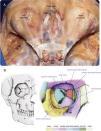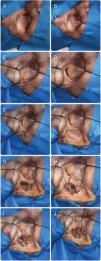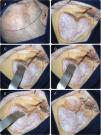The orbit is a structure of interest for many medical specialties. Surgical approaches to the orbit present significant difficulties for the general neurosurgeon. Whoever decides to practice orbital surgery must have vast anatomical knowledge of this structure. However, although many of the existing publications about orbital anatomy show the complexity of this structure in detail, they fail to facilitate their understanding.
The purpose of this study was to systematise and simplify the anatomical study of the orbit from a surgical perspective, to facilitate its understanding.
Materials and methodsA review of the international literature on the subject was carried out, and the principle of the rule of 7 was followed for its ordering. For illustration purposes, photographs of cadaveric preparations and digital drawings were used.
ResultsThe orbits are 2 cavities located symmetrically on both sides of the nose. They have a pyramidal shape, with 4sides, a posterior vertex, an anterior base and their axis established from the sagittal plane at a 20-degree angle. A distinctive feature of the orbit is that its elements are organised into groups of seven: 7bones, 7intraorbital extraocular muscles and 7nerves.
ConclusionA systematisation of the orbital anatomy was performed with clear illustrations to simplify its study. The understanding of the anatomy of the orbit is vital to classify lesions and provides a solid basis when choosing the most appropriate approach for their treatment.
La órbita es una estructura de interés para diversas especialidades médicas. Los abordajes quirúrgicos de la órbita presentan una dificultad significativa para el neurocirujano general. Quien decide incursionar en cirugía orbitaria debe tener un vasto conocimiento anatómico de esta estructura. Sin embargo, gran parte de las publicaciones existentes sobre anatomía de la órbita muestran detalladamente la complejidad de esta estructura, pero no logran facilitar su entendimiento. El propósito del presente trabajo es sistematizar el estudio anatómico de la órbita desde una perspectiva quirúrgica, de modo sencillo, que permita facilitar su entendimiento.
Materiales y métodosSe realizó una revisión de la literatura mundial sobre el tema y se siguió el principio de la regla del 7 para su ordenamiento. Para ilustrar se utilizaron fotografías de preparados cadavéricos y dibujos digitales.
ResultadosLas órbitas son 2cavidades ubicadas simétricamente a ambos lados de la nariz. Tienen una forma piramidal, de 4lados, con un vértice posterior, una base anterior y con su eje establecido desde el plano sagital en un ángulo de 20 grados. Una característica distintiva de la órbita es que sus elementos están organizados en grupos de a 7: 7huesos, 7músculos extraoculares intraorbitarios y 7nervios.
ConclusiónSe realizó una sistematización de la anatomía orbitaria con claras ilustraciones a fin de simplificar su estudio. La comprensión de la anatomía de la órbita es clave para clasificar una lesión y proporciona una base sólida a la hora de elegir el abordaje más adecuado para su tratamiento.
Article

If it is the first time you have accessed you can obtain your credentials by contacting Elsevier Spain in suscripciones@elsevier.com or by calling our Customer Service at902 88 87 40 if you are calling from Spain or at +34 932 418 800 (from 9 to 18h., GMT + 1) if you are calling outside of Spain.
If you already have your login data, please click here .
If you have forgotten your password you can you can recover it by clicking here and selecting the option ¿I have forgotten my password¿.













